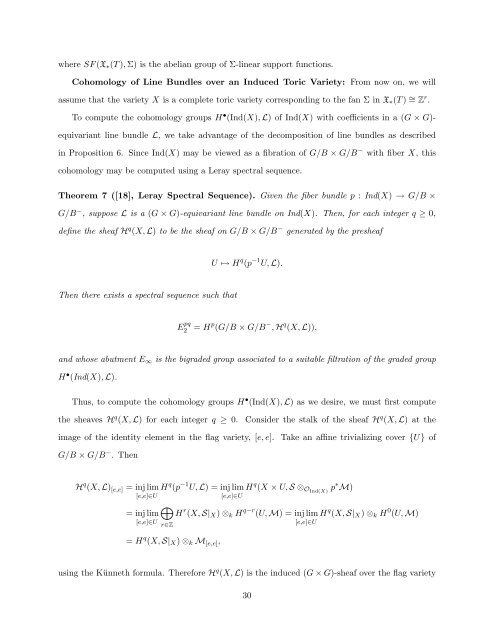Equivariant Embeddings of Algebraic Groups
Equivariant Embeddings of Algebraic Groups
Equivariant Embeddings of Algebraic Groups
Create successful ePaper yourself
Turn your PDF publications into a flip-book with our unique Google optimized e-Paper software.
where SF (X ∗ (T ), Σ) is the abelian group <strong>of</strong> Σ-linear support functions.<br />
Cohomology <strong>of</strong> Line Bundles over an Induced Toric Variety: From now on, we will<br />
assume that the variety X is a complete toric variety corresponding to the fan Σ in X ∗ (T ) ∼ = Z r .<br />
To compute the cohomology groups H • (Ind(X), L) <strong>of</strong> Ind(X) with coefficients in a (G × G)-<br />
equivariant line bundle L, we take advantage <strong>of</strong> the decomposition <strong>of</strong> line bundles as described<br />
in Proposition 6. Since Ind(X) may be viewed as a fibration <strong>of</strong> G/B × G/B − with fiber X, this<br />
cohomology may be computed using a Leray spectral sequence.<br />
Theorem 7 ([18], Leray Spectral Sequence). Given the fiber bundle p : Ind(X) → G/B ×<br />
G/B − , suppose L is a (G × G)-equivariant line bundle on Ind(X). Then, for each integer q ≥ 0,<br />
define the sheaf H q (X, L) to be the sheaf on G/B × G/B − generated by the presheaf<br />
U ↦→ H q (p −1 U, L).<br />
Then there exists a spectral sequence such that<br />
E pq<br />
2 = Hp (G/B × G/B − , H q (X, L)),<br />
and whose abutment E ∞ is the bigraded group associated to a suitable filtration <strong>of</strong> the graded group<br />
H • (Ind(X), L).<br />
Thus, to compute the cohomology groups H • (Ind(X), L) as we desire, we must first compute<br />
the sheaves H q (X, L) for each integer q ≥ 0.<br />
Consider the stalk <strong>of</strong> the sheaf H q (X, L) at the<br />
image <strong>of</strong> the identity element in the flag variety, [e, e]. Take an affine trivializing cover {U} <strong>of</strong><br />
G/B × G/B − . Then<br />
H q (X, L) [e,e] = inj lim<br />
[e,e]∈U<br />
= inj lim<br />
[e,e]∈U<br />
H q (p −1 U, L) = inj lim H q (X × U, S ⊗ OInd(X) p ∗ M)<br />
[e,e]∈U<br />
⊕<br />
r∈Z<br />
= H q (X, S| X ) ⊗ k M [e,e] ,<br />
H r (X, S| X ) ⊗ k H q−r (U, M) = inj lim H q (X, S| X ) ⊗ k H 0 (U, M)<br />
[e,e]∈U<br />
using the Künneth formula. Therefore H q (X, L) is the induced (G × G)-sheaf over the flag variety<br />
30
















